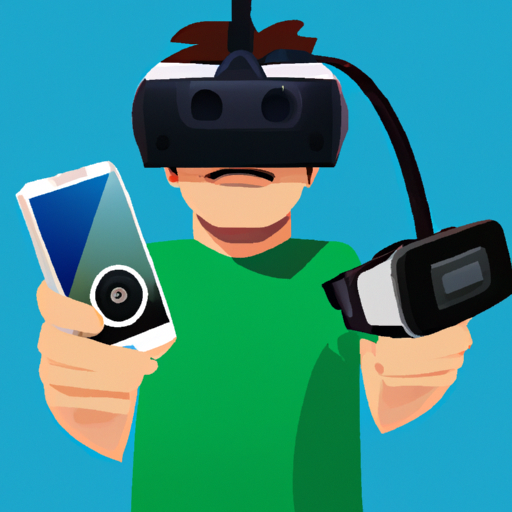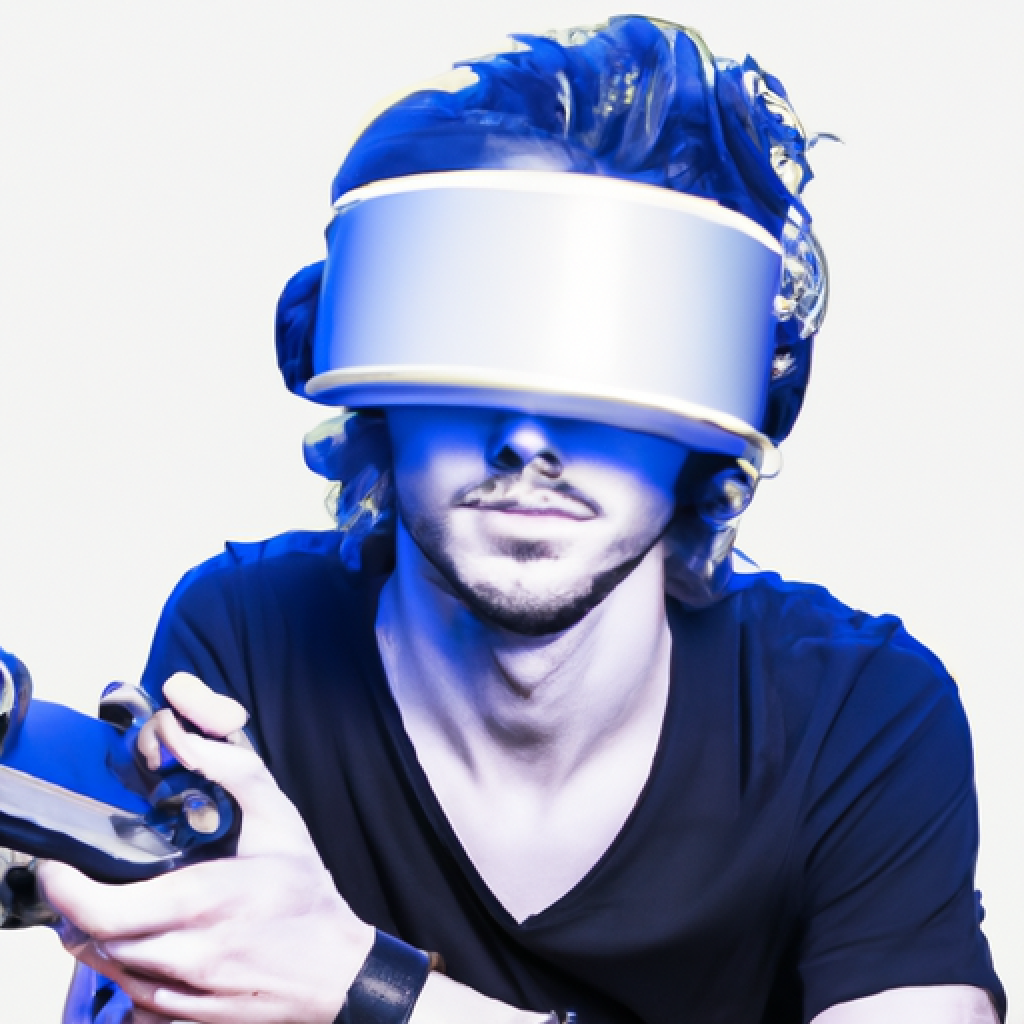What Devices Does VR Work On?

So, you’ve heard all the buzz about virtual reality (VR) and you’re wondering what devices this futuristic technology actually works on. Well, let me break it down for you. Whether you’re using a high-end gaming PC, a smartphone, or even a standalone headset, VR has become more accessible than ever before. With an array of devices ranging from the popular Oculus Rift and HTC Vive to the innovative Oculus Quest and smartphone-powered Google Cardboard, there’s something for everyone to experience the mind-bending world of virtual reality.

Understanding VR Technology
Virtual Reality (VR) technology is an immersive experience that allows users to interact with a computer-generated environment, simulating a three-dimensional world. It enables users to feel like they are a part of the virtual space, creating a sense of presence and engagement. With VR, users are not just passive observers; they can explore and interact within the virtual world in a more natural and intuitive way.
Definition of VR
Virtual Reality (VR) refers to a simulated experience that can be similar to or completely different from the real world. This technology creates a three-dimensional environment that users can explore and interact with. By using VR devices, such as headsets and motion controllers, users can be transported to a virtual world and have a first-person perspective of the surroundings.
How VR Works
VR works by presenting users with a digital simulation of a three-dimensional environment. It uses a combination of hardware and software components to create a sense of presence and immersion. The key components involved in the VR experience include a VR headset, motion tracking sensors, and hand controllers.
The VR headset is worn on the user’s head and typically covers their eyes, providing a stereoscopic view of the virtual world. The motion tracking sensors track the user’s head movements, allowing them to look around and interact with the virtual environment. Hand controllers enable users to manipulate objects and perform actions within the VR space.
The VR device captures the real-time movements of the user and translates them into corresponding movements within the virtual world. This synchronization between the user’s actions and the virtual environment creates a compelling and immersive experience.
Applications of VR
VR has a wide range of applications across various industries and fields. In gaming, VR provides a more immersive and realistic gaming experience, allowing players to feel like they are inside the game world. It also has applications in education, where students can explore virtual environments and interact with virtual objects to enhance their learning.
VR is also used in training simulations for industries such as aviation, healthcare, and defense. It enables trainees to practice and gain practical experience in a safe and controlled environment. VR is also utilized in architectural visualization, where designers can create virtual walkthroughs of buildings before construction.
Furthermore, VR has therapeutic applications, such as exposure therapy for phobias and post-traumatic stress disorder. By immersing patients in virtual environments that trigger their fears or traumas, therapists can help them confront and overcome their anxieties in a controlled and gradual manner.

VR Device Categories
VR devices can be categorized into four main types: PC-based, console-based, standalone, and smartphone-based. Each category has its own characteristics and features, catering to different user needs and preferences.
PC-based VR Devices
PC-based VR devices are connected to a computer that provides the necessary computational power and graphical capabilities. These devices offer high-quality graphics and immersive experiences but require a powerful computer to run smoothly. The most popular PC-based VR devices are Oculus Rift, HTC Vive, and Valve Index.
Oculus Rift
The Oculus Rift is one of the pioneering VR devices that kickstarted the modern VR industry. It provides a high-resolution display, accurate head tracking, and intuitive hand controllers. The Rift offers a wide range of games and applications through the Oculus Store, making it a popular choice for gamers and VR enthusiasts.
HTC Vive
The HTC Vive is another popular PC-based VR device that offers a room-scale VR experience. It uses laser sensors called Lighthouse to track the user’s movements within a designated play area. The Vive provides a highly immersive experience and precise tracking, allowing users to freely explore and interact with the virtual environment.
Valve Index
The Valve Index is a high-end PC-based VR device developed by Valve Corporation. It features a high-resolution display, precise hand tracking, and a wide field of view. The Index also offers additional accessories, such as knuckles controllers, that provide more immersive and intuitive interactions within the virtual world.
PC-based VR devices offer the advantage of superior graphics and a wider range of software options. However, they require a powerful computer and can be expensive, making them more suitable for dedicated VR enthusiasts and gamers.
Console-Based VR Devices
Console-based VR devices are designed to work with gaming consoles, such as PlayStation and Xbox. These devices provide an affordable and accessible entry point into VR, as they leverage the computing power of the consoles. The two main console-based VR devices are PlayStation VR and Xbox VR.
PlayStation VR
PlayStation VR (PSVR) is a VR headset designed to work with the PlayStation 4 console. It offers a comfortable and immersive VR experience, with a wide range of games and applications available through the PlayStation Store. The PSVR uses the PlayStation Camera and PlayStation Move controllers for motion tracking.
Xbox VR
While Microsoft has not released a dedicated VR headset for the Xbox console, it has announced support for VR on Windows Mixed Reality headsets. These headsets can be connected to a powerful gaming PC running Windows 10, providing VR capabilities for Xbox users. However, the Xbox VR ecosystem is not as developed as its PlayStation counterpart.
Console-based VR devices offer a more affordable and user-friendly option for experiencing VR. They are suitable for casual gamers who already own gaming consoles and want to explore VR without the need for a high-end gaming PC.
Standalone VR Devices
Standalone VR devices are self-contained systems that do not require a computer or gaming console to operate. These devices have built-in processors, displays, and motion tracking capabilities, providing a complete VR experience without external dependencies. The two main standalone VR devices are Oculus Quest and Pico Neo 2.
Oculus Quest
The Oculus Quest is a standalone VR device that offers a wireless and untethered VR experience. It features inside-out tracking, which means it uses built-in cameras to track the user’s movements without the need for external sensors or cables. The Quest provides a wide range of games and applications through the Oculus Store.
Pico Neo 2
The Pico Neo 2 is another standalone VR device that offers a portable and self-contained VR experience. It features six degrees of freedom (6DoF) tracking for precise movement detection. The Neo 2 is aimed at enterprise users and offers business-focused VR applications, such as training simulations and virtual meetings.
Standalone VR devices offer the advantage of convenience and portability. They are suitable for users who want a hassle-free and wireless VR experience. However, standalone devices may have limitations in terms of graphics quality and software availability compared to PC-based devices.
Smartphone-Based VR Devices
Smartphone-based VR devices utilize the computing power and display capabilities of smartphones to create a VR experience. These devices typically consist of a headset that holds the smartphone and lenses that provide the stereoscopic view. The two main smartphone-based VR devices are Samsung Gear VR and Google Daydream.
Samsung Gear VR
The Samsung Gear VR is a headset designed to work with Samsung smartphones. It offers a comfortable and affordable entry point into VR, leveraging the high-resolution displays of Samsung’s flagship smartphones. The Gear VR provides access to a wide range of VR content through the Oculus Store.
Google Daydream
Google Daydream is a platform for VR experiences that works with compatible Android smartphones. It includes a headset and a motion controller for interaction. Daydream provides a variety of VR apps and games through the Google Play Store, allowing users to explore virtual worlds on their smartphones.
Smartphone-based VR devices offer a cost-effective way to experience VR, as they leverage the existing capabilities of smartphones. They are suitable for casual users who want to dip their toes into VR without the need for dedicated VR devices.
Essential Hardware for Running VR
To run VR applications smoothly, certain hardware requirements should be met. These requirements include computational power, graphics card capabilities, and additional accessories for an optimal VR experience.
Computational Power Requirements
VR applications require a computer or gaming console with sufficient computational power to render high-resolution graphics and maintain a smooth frame rate. The specifications can vary depending on the VR device and the complexity of the VR experiences. A powerful processor, ample RAM, and fast storage are essential for running VR applications effectively.
Graphic Card Needs
A capable graphics card is crucial for delivering a visually stunning and immersive VR experience. VR applications demand real-time rendering of high-resolution graphical content, which can be taxing on the graphics card. For PC-based and console-based VR devices, a dedicated and high-performance graphics card is recommended to handle the demands of VR content.
Additional Accessories for VR
In addition to the core VR device, certain accessories can enhance the VR experience. These include motion controllers, haptic feedback devices, and VR-compatible peripherals. Motion controllers enable users to interact with the virtual environment more intuitively, while haptic feedback devices provide tactile sensations, enhancing immersion. VR-compatible peripherals, such as racing wheels and flight sticks, can further enhance the realism of specific VR experiences.

The Future of VR Devices
As VR technology continues to evolve, several advancements and trends are shaping the future of VR devices. These include wireless VR, eye-tracking VR, and mixed reality devices.
Wireless VR
Wireless VR is a significant development in the VR industry, eliminating the need for cables and allowing users to freely move within the VR space. Advancements in wireless transmission technologies, such as Wi-Fi 6, are enabling high-bandwidth and low-latency wireless VR experiences. Wireless VR devices, like the Oculus Quest, provide a more convenient and immersive experience, opening up new possibilities for VR applications.
Eye-Tracking VR
Eye-tracking technology allows VR devices to track the movement and focus of the user’s eyes. This technology can provide several benefits, such as foveated rendering, which dynamically adjusts the level of detail in the virtual scene based on the user’s gaze. Eye-tracking can also enable more natural interactions within the virtual world, such as selecting objects or controlling virtual avatars through eye movements.
Mixed Reality Devices
Mixed reality devices combine virtual reality and augmented reality to create a hybrid experience. These devices allow users to see and interact with both the real and virtual worlds simultaneously. Mixed reality devices, such as the Microsoft HoloLens, provide new possibilities for gaming, design, education, and other fields by merging physical and digital elements.
The future of VR devices looks promising, with advancements in wireless technology, eye-tracking capabilities, and mixed reality experiences. These developments will further enhance the immersive qualities of VR and open up new opportunities for various industries.
VR in Mobile Devices
Mobile devices, such as smartphones and tablets, are increasingly becoming platforms for experiencing VR. Both iOS and Android offer VR capabilities through dedicated apps and VR accessories.
VR on iOS
iOS devices, such as iPhones and iPads, can access VR content through apps like Google Cardboard, which provide a basic VR experience by utilizing the built-in gyroscope and accelerometer. Additionally, there are VR headsets designed specifically for iOS devices, such as the Homido VR headset, which offers a more immersive and comfortable VR experience.
VR on Android
Android devices have a more extensive VR ecosystem, with a variety of VR apps and headsets available. Google Cardboard is a popular option that works with a wide range of Android smartphones. Other headsets, like the Samsung Gear VR, offer a more advanced VR experience by leveraging the hardware and software optimizations provided by Samsung’s flagship smartphones.
Mobile VR provides a portable and accessible way to experience VR on the go. While it may not offer the same level of graphics and immersion as dedicated VR devices, it is a suitable option for casual users and those looking for a taste of VR without investing in dedicated VR equipment.

Limitations and Issues with VR Devices
While VR technology has come a long way, there are still some limitations and issues that users may encounter when using VR devices. These include motion sickness, hardware compatibility issues, and software support challenges.
Motion Sickness
Motion sickness is one of the most common issues experienced by VR users. It occurs when there is a disconnect between what the user sees in the virtual world and what their body feels in the real world. Rapid movements, changes in perspective, and inconsistent frame rates can trigger motion sickness symptoms, such as nausea, dizziness, and discomfort. Manufacturers and developers are continuously working to minimize motion sickness by optimizing the hardware, software, and VR experiences.
Hardware Compatibility Issues
VR devices require specific hardware configurations and compatibility with the operating system. PC-based VR devices, for example, require a powerful computer with specific specifications to run VR applications smoothly. Console-based VR devices only work with specific gaming consoles. Standalone VR devices often have limited processing power compared to PC-based devices. Smartphone-based VR devices require specific smartphones that meet the necessary requirements. Users need to ensure that their hardware is compatible with the VR device they intend to use.
Software Support
The availability and quality of VR software can vary depending on the VR device. PC-based VR devices offer a wider range of software options, with access to VR-dedicated stores and platforms. Console-based VR devices have a more limited selection of VR games and applications. Standalone VR devices and smartphone-based VR devices may have a smaller library of VR content compared to their PC and console counterparts. Users should consider the availability of software for their chosen VR device to ensure they have access to the experiences they desire.
Despite these limitations and issues, VR technology continues to advance, and manufacturers are addressing these challenges to improve the overall VR experience. As the technology matures, we can expect to see fewer limitations and a wider range of high-quality VR content.
In conclusion, VR technology has revolutionized the way we perceive and interact with digital environments. From gaming and education to training and therapy, VR has numerous applications across various industries. PC-based, console-based, standalone, and smartphone-based VR devices cater to different user needs and preferences. Understanding the hardware requirements, such as computational power and graphics capabilities, is crucial for a smooth VR experience. The future of VR devices looks promising with advancements in wireless technology, eye-tracking capabilities, and mixed reality experiences. While VR on mobile devices provides a more accessible and portable way to experience VR, there are still limitations and issues that need to be addressed. With continued advancements and improvements, VR technology has the potential to transform various aspects of our lives and reshape our digital experiences.







